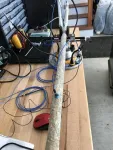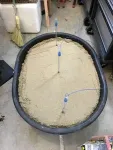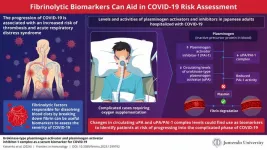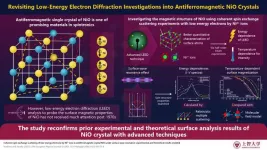(Press-News.org) As any percussionist or fidgety pen-tapper can tell you, different materials make different noises when you hit them. Researchers at Drexel University hope this foundational acoustic phenomenon could be the key to the speedy removal of lead water lines that have been poisoning water supplies throughout the country for decades. A recent study conducted with geotechnical engineering consultant Seaflower Consulting Services, showed that it is possible to discern a buried pipe’s composition by striking it and monitoring the sound waves that reach the surface. This method could guide water utility companies before they break ground to remove lead service lines.
In the aftermath of the 2014 water crisis in Flint, Michigan, many utility companies have been diligently working to verify the materials of their service lines. These efforts have become increasingly urgent in the last two years due to the Biden Administration’s Bipartisan Infrastructure Act and the Environmental Protection Agency’s Lead Service Line Replacement Accelerators initiative mandating the removal of all lead pipes, serving an estimated 9.2 million American households — putting utilities on the clock to finish the job by 2033.
“Lead pipes are clearly an urgent public health problem and replacing them is rightly a priority, particularly in urban areas,” said Ivan Bartoli, PhD, one of the leaders of the team and a professor in Drexel’s College of Engineering. “But the challenge in these areas is that many of the lines are so old that records may not exist and utility companies are left to verify whether or not they’re made of lead before they begin the costly and lengthy process of digging them up and replacing them.”
Other noninvasive options include water sampling, which doesn’t identify the source of contamination and may miss lead lines; and closed-circuit camera inspection, which is difficult to deploy from outside and is not as effective when used in old pipes due to corrosion and scale buildup.
The current standard for testing pipes — entering homes to directly test the service line, or alternatively, excavating the line to obtain the sample — can be inconvenient for homeowners, disruptive for citizens and costly for utility companies. And the time it takes to verify pipes this way makes it unlikely that urban areas will be lead-free on the EPA’s timeline.
In Philadelphia alone, the Water Department estimates that some 20,000 of the 511,000 properties in the city may have lead service lines. Since 2017, the department has only been able to replace 2,600 of them, so finding a faster and less-destructive way to pinpoint which lines are lead could be crucial for meeting the EPA’s deadline without digging up most of the city’s streets and sidewalks.
The Drexel team’s approach is based on monitoring ultrasonic stress wave propagation, a technique frequently used for checking the structural health of pipelines, railroads and aircraft wings. But rather than simply showing that different types of pipes produce discernably unique acoustic stress waves when struck, in their study, recently published in the Journal of Nondestructive Evaluation, the team took the extra step of showing that those waves can be detected at surface level and their propagation translated into a signature for each type of pipe.
“Since wave speed varies with material type, the first arrival time of the wave on top of the surface differs for different service line materials,” they wrote. “For instance, for lead, guided waves along the pipe are slower since lead bulk wave speeds are much lower than speeds of other service line materials.”
The team experimented in the lab with lead, copper, steel and polyvinyl chloride (PVC) pipes, using piezoelectric accelerometer sensors to record stress wave propagation through each when struck with an instrumentation hammer. They repeated the process after partially filling each pipe with water and again after burying it in 30 centimeters of sand.
With the data collected, the team produced models — called dispersion curves — showing how quickly the waves reached each sensor and how their speed changed over time for each type of pipe and in each setting. The team believes these models could be used to identify pipes in the field.
“These results present a promising opportunity for noninvasive identification of service lines,” said Charles Haas, PhD, LD Betz professor of environmental engineering in the College of Engineering and one of the project leaders. “Additional testing will be necessary to verify this approach and to collect data on how waves propagate through different types of soils and those that are not homogenous, but this is an important step toward a solution to a very big problem.”
The release of $15 billion in funding from the Bipartisan Infrastructure Act for lead pipe removal in urban areas, rural communities and schools and childcare facilities is putting additional pressure on utility companies to come up with a viable technology to speed the identification and removal process.
The team is in the process of designing and testing a prototype of a system that could be used for pipe identification in the field by placing sensors on the ground between the water main and the house and using a probe and hammer to strike the curb stop valve of the service line to induce the acoustic waves. They have partnered with several water utility companies to test the prototype and begin to collect data to refine their models.
“Utilities need to work quickly to map and verify their service lines, but they also must ensure that there are no misses,” said Kurt Sjoblom, PhD, a former professor in Drexel’s College of Engineering, who is the founder of Seaflower Consulting Services and a leader of the project. “If excavating their entire water system just isn’t feasible – a tool like this could help point them in the right direction and cut down on unnecessary excavation.”
END
Pinging pipes could help to identify lead water lines without excavation
Drexel University study shows sound waves can reveal composition of buried water lines
2024-03-07
ELSE PRESS RELEASES FROM THIS DATE:
A new manganese-fluorine catalyst with exceptional oxidizing power
2024-03-07
A research team, affiliated with UNIST has unveiled a cutting-edge catalyst with exceptional oxidizing power, capable of extracting electrons from compounds. Anticipated to revolutionize various fields, including the development of metal catalysts and synthetic chemistry, this catalyst marks a significant breakthrough in catalytic research.
Led by Professor Jaeheung Cho in the Department of Chemistry at UNIST, the research team successfully synthesized the pioneering manganese-fluorine catalyst, utilizing the Macrocyclic Pyridinophane System. This catalyst demonstrates the ability to induce oxidation reactions, ...
An aspirin a day? Poll of older adults suggests some who take it may be following outdated advice
2024-03-07
One in four older adults take aspirin at least three times a week, mostly in hopes of preventing heart attacks and strokes, a new poll shows.
But many people aged 50 to 80 who said they take aspirin may not need to, the findings from the University of Michigan National Poll on Healthy Aging suggest.
In all, 57% of people aged 50 to 80 who say they take aspirin regularly also said they don’t have a history of cardiovascular disease. Such people should have a conversation with their health care provider about what’s best for them before stopping or starting aspirin use.
National guidelines have changed in recent years for using aspirin for prevention, ...
What makes a pathogen antibiotic-resistant?
2024-03-07
Antimicrobial resistance is a story of constantly moving parts and players. With every new or tweaked antibiotic or antimicrobial drug, the targeted pathogens begin the evolutionary dance of acquiring resistance, prompting researchers to constantly develop workarounds or entirely new classes of medicine.
Understanding the underlying mechanisms of acquired antimicrobial resistance is critical to the fight, a case of knowing one’s enemy. In a new paper published March 2, 2024 in npj Antimicrobials and Resistance, part of the Nature Portfolio, researchers at Sanford Burnham Prebys, working with Roche Pharma Research and Early Development, ...
Method rapidly verifies that a robot will avoid collisions
2024-03-07
Before a robot can grab dishes off a shelf to set the table, it must ensure its gripper and arm won’t crash into anything and potentially shatter the fine china. As part of its motion planning process, a robot typically runs “safety check” algorithms that verify its trajectory is collision-free.
However, sometimes these algorithms generate false positives, claiming a trajectory is safe when the robot would actually collide with something. Other methods that can avoid false positives are typically too slow for robots in the real world.
Now, MIT researchers have developed a safety check technique which can prove with 100 percent accuracy ...
Eating habits, physical activity practice and clinical prognosis of colorectal cancer patients with overweight/obesity
2024-03-07
Background and objectives
Obesity is a chronic metabolic disease associated with the development of several other diseases, including cancer. The present study aims to evaluate the eating habits, physical activity, and clinical profiles of colorectal cancer (CRC) patients with overweight/obesity.
Methods
A cross-sectional study was conducted with data collected from the medical records of patients diagnosed with CRC (n = 41) from June 2019 to June 2022. Additionally, a questionnaire (n = 35) was applied to gather information on eating habits and physical activity. The data were ...
Exploring the effectiveness of a novel pain management device for endometriosis pain
2024-03-07
Endometriosis is a chronic condition affecting women, often resulting in painful symptoms such as menstrual cramps and pelvic pain. Pain caused by endometriosis significantly lowers the quality of life and reproductive health of affected women, with around one-third of women still experiencing pain and discomfort despite treatment. While hormonal therapies and surgeries are common treatments, they often do not result in complete alleviation of symptoms. Effectively managing pain is, therefore, crucial for managing ...
Fibrinolytic biomarkers for identifying patients at risk of severe COVID-19
2024-03-07
The global impact of the COVID-19 pandemic on healthcare systems has been significant. The sudden surge in infected cases overwhelmed hospitals and disrupted routine healthcare services, thus further worsening public health. Managing patients, too, has been challenging due to the variation of COVID-19 symptoms, ranging from mild to severe, that require medical intervention.
To help hospitals prioritize patients in need of care, researchers have been looking into various biological markers that can determine the risk of the disease becoming more severe. Among these, proteins in the blood related to blood clot formation, increased inflammation, and ...
Exploring the surface properties of NiO with low-energy electron diffraction
2024-03-07
Spintronics is a field that deals with electronics that exploit the intrinsic spin of electrons and their associated magnetic moment for applications such as quantum computing and memory storage devices. Owing to its spin and magnetism exhibited in its insulator-metal phase transition, the strongly correlated electron systems of nickel oxide (NiO) have been thoroughly explored for over eight decades. Interest in its unique antiferromagnetic (AF) and spin properties has seen a revival lately, since NiO is a potential material for ultrafast spintronics devices.
Despite this rise in popularity, exploration of its surface magnetic properties using ...
What drives students to take up teaching? New study explores aspirations and challenges faced by prospective teachers in Japan
2024-03-07
As role models and mentors for the youth, teachers play an important role in guiding children into well-rounded adults. However, excessive workloads and high skill expectations have allegedly led to teacher shortages in Japan. In 2022, the Ministry of Education Culture, Sports, Science, and Technology (MEXT) reported a record low in applicants for primary school teaching positions, and a survey from the same year revealed that 65.8% of 924 full-time educators expressed a desire to quit due to overwhelming demands.
To address the teacher shortage, Associate Professor Akihiro Saito from ...
Baby quasars: Growing supermassive black holes
2024-03-07
The James Webb Space Telescope makes one of the most unexpected findings within its first year of service: A high number of faint little red dots in the distant Universe could change the way we understand the genesis of supermassive black holes. The research, led by Jorryt Matthee, Assistant Professor in astrophysics at the Institute of Science and Technology Austria (ISTA), is now published in The Astrophysical Journal.
A bunch of little red dots found in a tiny region of our night sky might be an unexpected breakthrough for the James Webb Space Telescope (JWST) within its first year of service. These objects were indistinguishable from normal galaxies through the ...
LAST 30 PRESS RELEASES:
Australian team discover why quantum computers have memory problems over time
What determines the fate of a T cell?
Candida auris: genetic process revealed which could be treatment target for deadly fungal disease
Groundbreaking discovery turns household plastic recycling into anti-cancer medication
Blocking a key inflammatory pathway improves liver structure and vascular function in cirrhosis, study finds
Continuous spread: Raccoon roundworm detected in nine European countries
HKUST Engineering researchers developed a novel photodetector to enhance the performance of on-chip light monitoring
Strategic river sensors could have forewarned of Texas Camp flood disaster
Drone sampling of whale breath reveals first evidence of potentially deadly virus in Arctic
Roman soldiers defending Hadrian’s Wall infected by parasites, study finds
Pinochet’s prisoners were tormented with music but still found solace in it, a new book reveals
Fertility remains high in rural Tanzania despite access to family planning
AI-assisted device can improve autism care access
Kinetic careers
Uncovering how parasitic plants avoid attacking themselves to improve crop resistance
Nanoparticle vaccine strategy could protect against Ebola and other deadly filoviruses
Study finds brain care score can predict risk of stroke across racial groups
Key lung immune cells can intensify allergic reactions
Do hormones explain why women experience more gut pain?
New materials conduct ions in solids as easily as in liquids
Breakthrough of the Year: Renewable energy begins to eclipse fossil fuel-based sources
LLM use is reshaping scientific enterprise by increasing output, reducing quality and more
Introducing LightGen, a chip for ultra-fast, ultra-efficient generative AI
Astronomers see fireworks from violent collisions around nearby star
ACC/AHA issue new guideline on managing congenital heart disease in adults
Cosmic crash caught on camera
Is talented youth nurtured the wrong way? New study shows: top performers develop differently than assumed
Ants: An untapped resource in the development of antibiotics?
Archaeologists use AI to create prehistoric video game
Mitochondria migrate toward the cell membrane in response to high glucose levels
[Press-News.org] Pinging pipes could help to identify lead water lines without excavationDrexel University study shows sound waves can reveal composition of buried water lines









